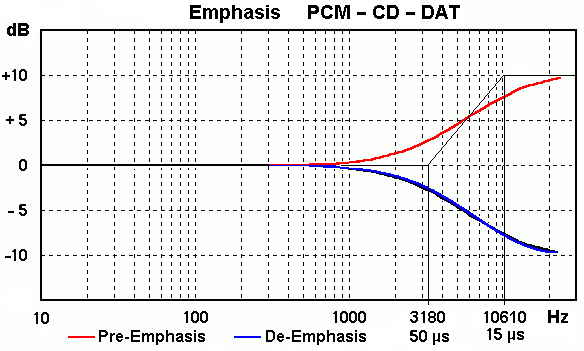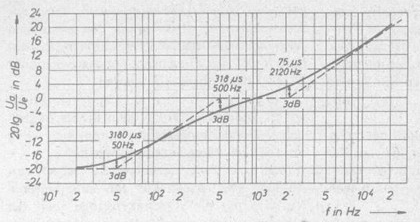

| Deutsche Version |
| Fill in the box above and click at the appropriate 'calculate' below. The Greek letter for the time constant is tau = τ and 1 microsecond is 10−6 seconds. |
| Time constant τ in µs |
Cut-off frequency fc in Hz |
Equalization emphasis |
| 7958 | 20 | • (RIAA) |
| 3183 | 50 | • RIAA, NAB |
| 1592 | 100 | |
| 318 | 500 | • RIAA |
| 200 | 796 | |
| 140 | 1137 | |
| 120 | 1326 | MC |
| 100 | 1592 | |
| 90 | 1768 | MC |
| 75 | 2122 | • RIAA, FM |
| 70 | 2274 | |
| 50 | 3183 | NAB, PCM, FM |
| 35 | 4547 | DIN |
| 25 | 6366 | |
| 17.5 | 9095 | AES |
| 15 | 10610 | PCM |
| 12.5 | 12732 | |
| 10 | 15915 |
Cut-off frequency: ![]()
Time constant: ![]()
Conditional equations:
Cut-off frequency fc in Hz = 159155 / τ in µs
Time constant τ in µs = 159155 / fc in Hz
 |
The possible pre-emphasis/de-emphasis of a PCM recording for DAT or CD (15/50 µs EIAJ DAT/CD).
Cut-off frequency: ![]()
Time constant: ![]()
Conditional equations:
Cut-off frequency fc in Hz = 159155 / τ in µs
Time constant τ in µs = 159155 / fc in Hz
|
Time constant and cut-off frequency
AME - Ampex Master Equalization Curve
Pre-Emphasis and De-Emphasis or preemphasis and deemphasis
| There was also an "Ampex Master Equalization" around the year 1958, called AME. It was
based on modifying the NAB response with an auditory (hearing) curve, which resulted in a
recorded flux that had a "hump" (re the NAB EQ) from about +3 dB at 630 Hz to +8 dB at 2 kHz, back to +3 dB at 5 kHz, and down to −12 dB at 16 kHz; see the AME curve: http://home.comcast.net/~mrltapes/pubame.pdf http://www.richardhess.com/tape/ame_equalizer_20040412.pdf |
| In USA FM radio has a time constant of 75 µs, but also in Korea,
Taiwan, Thailand, AFN worldwide and the rest of America. In Europe FM radio has a time constant of 50 µs, but also in Africa, Asia (without Korea, Taiwan, Thailand), Pacific. |
 |
| To use the calculator, simply enter a value. The calculator works in both directions of the ↔ sign. |
Time constant τ = R × C R = τ / C C = τ / R
Time constant in seconds = Resistance in ohms × Capacitance in Farad
Please enter two values, the third value will be calculated.
| Corner angular frequency ωc = Angular frequency ωc The corner angular frequency ωc is developed from the corner frequency fc: ωc = 2 π × fc Corner frequency fc = Cut-off frequency fc For systems that correspond to a differential equation of first grades the cutoff point is the intersection of the horizontal asymptote with the asymptote of the falling branch of the Bode diagram. At this point, the level is −3 dB and the phase shift is 45°. This means that the amplitude drop of the output value reached 30% of the input size. At the same time the time constant τ of such system is: τ = 1 / ωc = 1 / 2 π × fc |
| To use the calculator, simply enter a value. The calculator works in both directions of the ↔ sign. |
The increase of 20 dB per decade is equivalent to the increase of 6 dB per octave
| 6 dB/octave = 20 dB/decade 12 dB/octave = 40 dB/decade 18 dB/octave = 60 dB/decade 24 dB/octave = 80 dB/decade 20/6.0206 = 3.3219 There are 3.322 octaves in 1 decade, so 1 dB/decade = 3.322 × dB/octave. |
| To use the calculator, simply enter a value. The calculator works in both directions of the ↔ sign. |
| back |
Search Engine |
home |